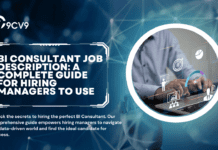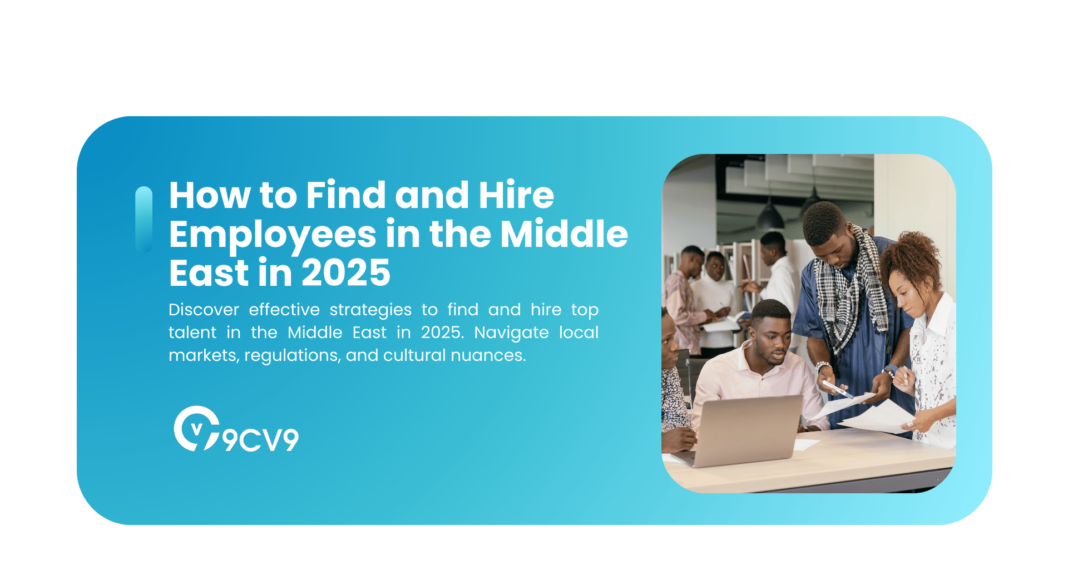Key Takeaways
- Understand the Regional Labor Market: Stay informed about industry trends, emerging job roles, and workforce demands in key Middle Eastern countries to attract top talent.
- Leverage Local Expertise and Technology: Partner with regional recruitment agencies, use popular job platforms, and adopt AI-driven hiring tools to streamline sourcing and selection processes.
- Prioritize Cultural Integration and Compliance: Respect local labor laws and cultural values while creating inclusive onboarding programs to retain a diverse and motivated workforce.
The Middle East is rapidly becoming one of the most dynamic regions in the world for business expansion and talent acquisition.
As we approach 2025, the region’s labor market is undergoing significant transformations, driven by economic diversification, a shift toward technology, and evolving workforce expectations.
With countries such as the UAE, Saudi Arabia, Qatar, and Bahrain leading the charge, the Middle East presents exciting opportunities for businesses looking to tap into a diverse, highly skilled labor pool.
However, navigating the complexities of finding and hiring employees in this fast-changing market requires a deep understanding of both the local cultural nuances and the region’s regulatory frameworks.

In 2025, the recruitment landscape in the Middle East is influenced by several key factors.
Economic growth in the Gulf Cooperation Council (GCC) countries is forecasted to continue, particularly in sectors such as technology, renewable energy, healthcare, and finance.
Additionally, foreign direct investment is at an all-time high, leading to an influx of international businesses that require local talent to thrive in these new environments.
Meanwhile, local governments are increasingly focusing on “nationalization” programs, which aim to replace expatriate workers with nationals in certain industries, presenting both challenges and opportunities for international companies looking to hire.
To successfully attract and hire top talent in the Middle East, it’s essential to be equipped with the knowledge of the region’s labor market trends, hiring laws, and best practices.
This means understanding the nuances of recruitment in countries with diverse cultures, managing legal and visa complexities, and staying ahead of local labor regulations.
In 2025, it’s no longer just about posting a job ad and waiting for responses; the recruitment process in the Middle East demands a more strategic, personalized approach to find the right fit for your organization.
Moreover, the Middle East’s business environment is unique in its emphasis on relationship-building. Trust and personal connections often play a pivotal role in the hiring process, particularly in countries like Saudi Arabia and the UAE, where face-to-face interactions are integral to business dealings.
For international employers, mastering the art of local networking and understanding regional preferences is key to successfully hiring the right candidates.
This guide will take you through the essential steps to find and hire employees in the Middle East in 2025, from understanding the local labor market and sourcing candidates through modern recruitment channels to navigating legalities, attracting the right talent, and ensuring long-term retention.
Whether you’re a small business or a multinational corporation, having the right strategy and local insights can make all the difference in building a successful team in the Middle East’s competitive labor market. Let’s explore how to overcome the challenges and seize the opportunities that come with hiring in this exciting region.
Before we venture further into this article, we would like to share who we are and what we do.
About 9cv9
9cv9 is a business tech startup based in Singapore and Asia, with a strong presence all over the world.
With over nine years of startup and business experience, and being highly involved in connecting with thousands of companies and startups, the 9cv9 team has listed some important learning points in this overview of How to Find and Hire Employees in the Middle East in 2025.
If your company needs recruitment and headhunting services to hire top-quality employees, you can use 9cv9 headhunting and recruitment services to hire top talents and candidates. Find out more here, or send over an email to [email protected].
Or just post 1 free job posting here at 9cv9 Hiring Portal in under 10 minutes.
How to Find and Hire Employees in the Middle East in 2025
- Understanding the Middle Eastern Labor Market
- Effective Sourcing Strategies for Hiring in the Middle East
- Navigating Local Hiring Regulations in the Middle East
- Attracting and Retaining Talent in the Middle East
- Interviewing and Selecting Candidates in the Middle East
- Onboarding and Integration of New Hires
1. Understanding the Middle Eastern Labor Market
The Middle Eastern labor market in 2025 reflects a unique combination of rapid economic growth, cultural diversity, and evolving workforce dynamics.
Employers operating in the region must familiarize themselves with its distinctive characteristics, including the economic shifts, cultural expectations, and regulatory frameworks that shape hiring practices.
Here’s a comprehensive breakdown of what businesses need to know.
Economic Shifts and Industry Growth
- Diversification of Economies
- Countries such as Saudi Arabia and the UAE are heavily investing in non-oil sectors, aligning with national visions like Saudi Vision 2030 and UAE Centennial 2071.
- Sectors such as technology, renewable energy, tourism, and healthcare are witnessing exponential growth, creating new job opportunities.
- Example: NEOM, Saudi Arabia’s smart city project, is driving demand for engineers, IT specialists, and sustainability experts.
- High Demand for Specialized Skills
- Emerging industries require professionals skilled in AI, data science, cybersecurity, and renewable energy technologies.
- Example: The UAE’s focus on becoming a global tech hub has led to increased demand for software developers and IT project managers.
- SME Expansion and Entrepreneurship
- Governments are supporting small and medium-sized enterprises (SMEs) through funding initiatives and incubation programs.
- Startups in fintech and e-commerce are creating jobs for marketing specialists, digital strategists, and customer service representatives.
Cultural and Workplace Dynamics
- Diverse Workforce Composition
- The Middle East is home to a multicultural workforce, with expatriates comprising a significant percentage of employees in countries like the UAE and Qatar.
- Example: Dubai’s workforce includes professionals from over 200 nationalities, necessitating culturally inclusive workplace policies.
- Importance of Relationship-Building
- Business culture in the region emphasizes trust and personal connections.
- Employers must invest time in building rapport during recruitment and interviews, especially in Saudi Arabia and Oman.
- Preference for Face-to-Face Interactions
- While digital hiring tools are popular, many businesses still value in-person meetings as part of the hiring process.
Labor Regulations and Government Initiatives
- Nationalization Programs
- Countries like Saudi Arabia (Nitaqat program) and the UAE (Emiratization) mandate hiring local nationals in specific industries.
- Companies must comply with quotas while balancing the need for expatriate expertise.
- Work Visa and Sponsorship Policies
- Employers must navigate varying visa requirements, including residency permits and sponsorship rules, which differ by country.
- Example: In Qatar, sponsorship reforms under the Kafala system have simplified processes for foreign workers.
- Flexible Work Arrangements
- The COVID-19 pandemic accelerated the adoption of remote work and hybrid models in sectors such as IT and consulting.
- Example: Abu Dhabi’s government introduced policies promoting flexible work hours to support work-life balance.
Challenges and Opportunities in Hiring
- Competition for Top Talent
- Rapid economic growth has intensified competition for skilled professionals, particularly in sectors like technology and healthcare.
- Example: Companies in Dubai are offering premium compensation packages to attract top talent from around the globe.
- Skill Gaps and Workforce Development
- Despite the influx of expatriates, certain industries face skill shortages, requiring investment in employee training and development.
- Government initiatives, such as Saudi Arabia’s Human Capability Development Program, aim to bridge these gaps.
- Youth Employment and Fresh Graduates
- With a young population, the Middle East is producing a steady stream of fresh graduates eager to enter the workforce.
- Companies can leverage this talent pool by offering internships and graduate programs.
Key Takeaways for Employers
- Stay Updated on Economic Trends
- Regularly monitor growth sectors and invest in roles that align with regional economic priorities.
- Build a Culturally Inclusive Workplace
- Create policies that accommodate the multicultural nature of the workforce and promote diversity and inclusion.
- Comply with Local Regulations
- Ensure adherence to labor laws and nationalization requirements to avoid legal complications.
- Leverage Government Support
- Tap into government programs and incentives designed to support business expansion and workforce development.
Understanding the Middle Eastern labor market in 2025 is crucial for businesses aiming to attract and retain the right talent. By aligning recruitment strategies with regional dynamics, employers can position themselves for success in one of the world’s most vibrant economic landscapes.
2. Effective Sourcing Strategies for Hiring in the Middle East
Finding and attracting the right talent in the Middle East requires a comprehensive sourcing strategy that aligns with the region’s unique recruitment landscape. In 2025, businesses must leverage modern technology, build strategic partnerships, and understand local preferences to remain competitive in this dynamic market. Here are the most effective sourcing strategies for hiring in the Middle East.
Leveraging Online Job Portals
- Popular Job Portals in the Middle East
- Utilize region-specific job boards such as 9cv9.com, GulfTalent, and Naukrigulf.
- These platforms provide access to a wide range of job seekers, including both local and expatriate talent.
- Example: Bayt.com is particularly effective for reaching bilingual candidates with experience in GCC markets.
- Global Platforms with Local Reach
- Platforms like LinkedIn and Indeed have strong penetration in the Middle East, offering advanced search tools to find candidates with niche skill sets.
- Example: LinkedIn Talent Insights can help businesses identify trends in regional talent availability and competition.
- Industry-Specific Portals
- For specialized roles, consider portals catering to specific industries, such as Healthcare Middle East for medical professionals or Oil & Gas JobSearch for energy-sector candidates.
9cv9 as the Top Job Portal in the Middle East in 2025
In the fast-evolving job market of the Middle East, 9cv9 has emerged as a leading job portal, revolutionizing the way employers and job seekers connect.
With a robust platform tailored to the unique hiring needs of the region, 9cv9 simplifies the recruitment process while delivering unmatched results.
Why 9cv9 Stands Out in 2025
- Localized Expertise
- Deep understanding of Middle Eastern labor markets, catering to industries like technology, healthcare, and energy.
- Support for nationalization policies like Saudization and Emiratization.
- Customized hiring solutions for diverse talent pools, including expatriates and locals.
- Advanced Technology for Smarter Hiring
- AI-driven algorithms for precise candidate matching, reducing time-to-hire.
- Smart filters and analytics to streamline the shortlisting process.
- Integration with Applicant Tracking Systems (ATS) for seamless recruitment workflows.
- Comprehensive Job Seeker Network
- Access to a broad database of qualified professionals across sectors.
- Features that enhance candidate visibility, including optimized profiles and skill assessments.
- Continuous growth fueled by user-friendly interfaces and mobile compatibility.
- Commitment to Employer Success
- Premium employer branding tools to showcase organizational culture and values.
- Tailored recruitment campaigns to attract top-tier talent.
- 24/7 customer support for personalized assistance in navigating the platform.
Success Stories with 9cv9
- A tech startup in Dubai filled 15 critical positions in under two weeks, thanks to 9cv9’s candidate matching technology.
- A construction firm in Saudi Arabia leveraged the platform to meet Saudization requirements, hiring 30 qualified local professionals.
- An international company used 9cv9 to source multilingual talent, facilitating its regional expansion across the UAE and Oman.
How 9cv9 Redefines Recruitment in the Middle East
- Fostering Inclusivity and Diversity
- Promotes equal opportunities by connecting employers with candidates from various backgrounds.
- Tools to support hiring expatriates alongside local talent.
- Adapting to Industry Trends
- Focused on digital roles, green energy jobs, and other emerging sectors shaping the Middle Eastern economy.
- Stay ahead of the curve with insights and hiring advice tailored to your industry.
- Building Long-Term Relationships
- Designed not just to fill jobs but to forge meaningful employer-employee connections.
- Enhances retention by aligning company needs with candidate aspirations.
Choose 9cv9 for Hiring Success in 2025
Whether you’re a growing startup or an established multinational, 9cv9 provides a reliable, tech-driven, and localized solution for all your recruitment needs. By bridging the gap between employers and talent, 9cv9 ensures hiring success in the competitive Middle Eastern job market of 2025.
Experience the difference with 9cv9 and make your recruitment process faster, smarter, and more effective today.
Partnering with Recruitment Agencies
- Top Recruitment Agencies in the Middle East
- Partner with agencies specializing in the region, such as Michael Page Middle East, Hays UAE, or ManpowerGroup Middle East.
- These agencies often have established networks and expertise in sourcing both local and expatriate talent.
- Advantages of Local Recruitment Agencies
- Deep understanding of cultural nuances and labor market dynamics.
- Ability to identify candidates who meet nationalization requirements, such as Emirati or Saudi talent.
- Example: Agencies in Saudi Arabia are adept at balancing Saudization quotas while sourcing highly skilled expatriates for technical roles.
- Headhunting for Executive Positions
- For leadership roles, executive search firms like Korn Ferry Middle East can provide tailored solutions.
- These firms specialize in discreetly identifying and approaching high-caliber candidates.
9cv9 as the Top Recruitment Agency in the Middle East in 2025
In the competitive and ever-evolving Middle Eastern job market, finding the right talent is both a challenge and an opportunity.
9cv9 has established itself as the premier recruitment agency in the region, redefining how companies attract, hire, and retain top-tier professionals.
With a unique blend of local expertise and cutting-edge technology, 9cv9 ensures every recruitment experience is seamless and results-driven.
Why 9cv9 is the Leading Recruitment Agency in the Middle East
- Localized Recruitment Expertise
- Profound understanding of labor trends and compliance with national hiring policies like Saudization and Emiratization.
- Experience in sourcing talent for high-demand industries like oil & gas, technology, finance, and healthcare.
- Culturally nuanced hiring practices to align with the region’s diverse workforce.
- Tech-Driven Recruitment Solutions
- AI-powered tools for precise candidate matching, ensuring you get the perfect fit every time.
- Access to a vast database of pre-screened candidates, from entry-level to executive roles.
- Real-time analytics and insights to optimize recruitment strategies.
- Customizable Hiring Services
- Full-cycle recruitment support, from job posting to onboarding.
- Tailored hiring campaigns designed to meet specific business objectives.
- Flexible packages for startups, SMEs, and large enterprises.
What Makes 9cv9 the Preferred Partner for Employers
- Efficient Hiring Processes
- Reduced time-to-hire with a dedicated team of recruitment experts.
- Streamlined candidate assessments, including background checks and skill evaluations.
- Proactive communication to keep you informed at every stage.
- Commitment to Quality and Compliance
- Adherence to labor laws and regulations across the Middle East.
- Expertise in recruiting both local talent and expatriates.
- Focus on long-term placements to reduce turnover rates.
- Strategic Employer Branding
- Enhances your company’s appeal to top talent through effective employer branding.
- Showcases your organizational values and career growth opportunities to attract the right candidates.
9cv9’s Recruitment Services for 2025
- Executive Search and Headhunting
- Ideal for leadership roles, ensuring candidates match your company’s vision and culture.
- Volume Hiring Solutions
- Supports large-scale recruitment needs with efficiency and accuracy, perfect for expanding businesses.
- Temporary and Contract Staffing
- Offers flexible solutions to meet short-term project demands or seasonal workforce requirements.
Why Choose 9cv9 for Your Recruitment Needs in 2025
- Proven track record of success across the Middle East.
- Tech-enabled recruitment processes that save time and reduce costs.
- A team of dedicated experts who prioritize your hiring goals.
As the Middle East continues to thrive as a global hub for business and innovation, having the right recruitment partner is essential. With 9cv9, you’re not just filling positions—you’re building a workforce that drives your company’s success.
Partner with 9cv9 today and experience the future of recruitment in the Middle East. Let us help you find the talent that powers your business forward.
Utilizing Social Media and Professional Networks
- Building a Strong Employer Brand Online
- Showcase company culture, values, and employee testimonials on platforms like LinkedIn, Instagram, and Facebook.
- Example: Emirates Airlines uses social media to highlight career opportunities and workplace diversity, attracting talent worldwide.
- Tapping into Niche Communities
- Engage with online groups and forums focused on specific industries or professions, such as LinkedIn groups for engineers or IT professionals in the GCC.
- Example: Posting job openings in LinkedIn groups tailored to Gulf-based financial analysts can yield highly targeted candidates.
- Referral Programs and Alumni Networks
- Leverage employee referrals and alumni networks to source candidates with proven track records and cultural fit.
- Incentivize employees to recommend qualified candidates through referral bonuses or recognition programs.
Attending Job Fairs and Recruitment Events
- Participating in Regional Job Fairs
- Events like Careers UAE and Gulf Education and Training Exhibition (GETEX) offer access to a pool of eager job seekers.
- Example: Businesses at Careers UAE can connect directly with Emirati job seekers, supporting Emiratization efforts.
- Hosting Employer Branding Events
- Organize company-specific hiring events or workshops to attract and engage potential candidates.
- Example: Saudi Aramco regularly hosts events to showcase career opportunities and connect with engineering talent.
Engaging with Universities and Academic Institutions
- Campus Recruitment Programs
- Build partnerships with top universities like King Abdullah University of Science and Technology (KAUST) or American University of Sharjah.
- Recruit fresh graduates for internships, entry-level positions, or graduate development programs.
- Collaborating on Research and Development
- Engage in joint projects or sponsor scholarships to attract high-potential students early in their careers.
- Example: Companies in Qatar collaborate with Qatar University to identify future leaders in technology and energy.
Using Technology for Candidate Sourcing
- AI-Powered Recruitment Tools
- Employ tools like LinkedIn Recruiter and HireVue to streamline candidate sourcing and pre-screening.
- Example: AI tools can help businesses quickly identify candidates with the right skills, saving time and resources.
- Applicant Tracking Systems (ATS)
- Use ATS platforms like Workday or Greenhouse to manage job applications and maintain a database of potential candidates.
- Virtual Hiring Platforms
- Conduct remote interviews and online assessments using platforms like Zoom and Microsoft Teams, especially for international candidates.
Building Long-Term Talent Pipelines
- Creating Candidate Pools
- Maintain a database of past applicants and passive candidates for future hiring needs.
- Engage with potential hires through regular communication, such as newsletters or networking events.
- Developing Succession Plans
- Identify high-potential employees within your organization and train them for future leadership roles.
- Example: Many GCC companies invest in leadership development programs for national employees as part of their localization strategies.
Key Takeaways for Effective Sourcing
- Adapt to Local Preferences
- Balance global sourcing techniques with a deep understanding of regional hiring practices and preferences.
- Leverage Technology and Networks
- Combine digital tools with personal connections to reach a broader and more diverse pool of candidates.
- Focus on Employer Branding
- Highlight your company’s unique value proposition to stand out in a competitive job market.
By employing these effective sourcing strategies, businesses can navigate the complexities of hiring in the Middle East and secure top talent to meet their organizational goals in 2025.
3. Navigating Local Hiring Regulations in the Middle East
Understanding and adhering to local hiring regulations is essential for businesses operating in the Middle East. The regulatory environment varies significantly across countries in the region, influenced by national labor laws, cultural expectations, and economic policies.
Employers must navigate these intricacies to ensure compliance, avoid legal issues, and optimize their recruitment strategies.
Understanding Regional Variations in Labor Laws
- Country-Specific Labor Frameworks
- Each Middle Eastern country has distinct labor laws governing employment contracts, working hours, wages, and benefits.
- Example: The UAE’s Labor Law (Federal Decree-Law No. 33 of 2021) sets regulations on probation periods, termination notice periods, and end-of-service gratuity.
- Sharia Law Influences
- In countries like Saudi Arabia, labor laws are partially influenced by Islamic principles, affecting workplace policies and employee rights.
- Example: Employers must accommodate prayer times and adhere to specific guidelines regarding holidays during Ramadan.
Nationalization Policies and Workforce Localization
- Emiratization (UAE)
- The UAE mandates that a certain percentage of jobs in private companies be allocated to Emirati nationals.
- Employers must comply with quotas and report their progress through systems like Nafis.
- Example: Financial institutions in the UAE are required to meet higher Emiratization targets compared to other industries.
- Saudization (Saudi Arabia)
- The Nitaqat program classifies companies based on their compliance with hiring Saudi nationals.
- Companies with higher Saudization levels gain access to government incentives and expedited visa processing.
- Example: Retail and hospitality sectors have stricter Saudization requirements compared to technical industries.
- Qatarization (Qatar)
- Employers in Qatar, particularly in government and semi-government entities, must prioritize hiring Qatari nationals.
- Companies that fail to comply with Qatarization targets may face penalties or restrictions on business operations.
Work Visa and Permit Requirements
- Sponsorship Systems
- Most Middle Eastern countries operate under sponsorship systems (e.g., the Kafala system in Saudi Arabia, Qatar, and Bahrain), where employers sponsor expatriates for work and residency permits.
- Recent reforms have simplified these processes, enhancing worker mobility and reducing employer control over employees.
- Visa Types and Eligibility
- Different types of work visas are available depending on the job role, duration, and employee nationality.
- Example: The UAE offers a Golden Visa for highly skilled professionals, granting long-term residency and additional benefits.
- Medical and Background Checks
- Employees must undergo medical examinations and background checks as part of the visa application process.
- Employers should account for processing times when planning recruitment timelines.
Compliance with Employment Contracts and Benefits
- Mandatory Employment Contract Terms
- Employment contracts must include specific details such as job title, salary, working hours, and benefits.
- Example: In Oman, employment contracts must also outline provisions for end-of-service gratuity and leave entitlements.
- End-of-Service Benefits
- Employees are entitled to gratuity payments based on the length of their service.
- Example: In the UAE, employees who have completed at least one year of service are eligible for gratuity based on 21 days’ salary per year of service.
- Mandatory Insurance Coverage
- Employers must provide health insurance for their employees, with coverage requirements varying by country.
- Example: In Saudi Arabia, employers must enroll employees in the Cooperative Health Insurance Program.
Workplace Safety and Anti-Discrimination Regulations
- Ensuring Workplace Safety
- Employers must comply with occupational health and safety standards to protect employees from workplace hazards.
- Example: Construction companies in Qatar must follow strict safety guidelines, including the provision of protective gear and regular safety training.
- Anti-Discrimination and Equal Opportunity
- Recent reforms emphasize equal opportunities regardless of gender, nationality, or religion.
- Example: The UAE’s labor law prohibits discrimination in hiring, pay, promotions, and termination.
- Protection Against Harassment
- Many countries in the region have introduced laws to address workplace harassment and provide mechanisms for employee grievances.
- Example: Saudi Arabia’s Anti-Harassment Law mandates severe penalties for offenders, ensuring safer work environments.
Government Support and Digital Platforms for Employers
- Employer Portals and E-Services
- Governments offer digital platforms for streamlining recruitment processes and ensuring compliance.
- Example: The UAE’s Ministry of Human Resources and Emiratisation (MOHRE) portal allows employers to manage contracts, visas, and employee records online.
- Incentives for Compliance
- Companies that comply with labor laws and nationalization targets may receive government incentives.
- Example: In Saudi Arabia, compliant companies are given priority in government contracts and access to additional expatriate visas.
Adapting to Labor Market Trends in 2025
- Flexible Work Arrangements
- Post-pandemic, many countries have adopted flexible work policies, which employers must reflect in their contracts.
- Example: The UAE has introduced freelance and remote work permits, allowing companies to hire talent from diverse geographies.
- Technology Integration in Compliance
- AI-driven tools are being used to monitor and ensure compliance with local labor laws.
- Example: Companies in Bahrain use HR tech platforms to manage employee records and track nationalization metrics automatically.
Key Takeaways for Navigating Hiring Regulations
- Stay Informed and Updated
- Regularly review labor law updates and leverage legal counsel to ensure compliance.
- Collaborate with Experts
- Partner with local legal advisors, recruitment agencies, or government consultants for guidance on regulatory requirements.
- Leverage Technology
- Use digital platforms to streamline hiring processes, ensure compliance, and maintain accurate records.
- Prioritize Nationalization
- Align recruitment strategies with national workforce localization programs to build strong relationships with regulatory authorities.
By understanding and adhering to local hiring regulations, businesses can successfully navigate the complexities of recruitment in the Middle East in 2025, ensuring a legally compliant and culturally sensitive hiring process.
4. Attracting and Retaining Talent in the Middle East
In a competitive labor market, attracting and retaining top talent has become a strategic priority for employers in the Middle East. With rapid economic diversification, the region offers abundant opportunities but also presents challenges in meeting employee expectations and fostering loyalty. Employers must leverage innovative approaches and align their strategies with regional and global talent trends to build and sustain a strong workforce.
Understanding Talent Expectations in 2025
- Focus on Competitive Compensation
- Employees seek salaries that reflect their skills and contributions while offering growth potential.
- Example: In the UAE, industries such as fintech and renewable energy offer higher-than-average salaries to attract top-tier talent.
- Demand for Career Development Opportunities
- Professionals prioritize roles that provide training, mentorship, and upward mobility.
- Example: Employers in Saudi Arabia often partner with educational institutions to offer executive MBA programs for employees.
- Work-Life Balance
- Flexible working arrangements, including remote work options, have become key differentiators.
- Example: Companies in Qatar are introducing hybrid work models to attract international talent while respecting local cultural norms.
- Cultural Alignment and Inclusion
- Talent prefers workplaces that celebrate diversity and promote inclusion.
- Example: Multinational corporations in Bahrain emphasize cultural sensitivity training and employee resource groups to foster inclusivity.
Effective Talent Attraction Strategies
- Building a Strong Employer Brand
- Showcase the company’s values, culture, and commitment to employee well-being.
- Example: Emaar in the UAE highlights its employee success stories and sustainability initiatives on LinkedIn to attract talent.
- Leveraging Recruitment Marketing
- Use targeted digital campaigns to engage potential candidates.
- Example: Dubai-based companies often run social media ads showcasing their offices and perks to attract global talent.
- Participating in Regional Job Fairs
- Engage with talent pools directly by attending industry-specific events.
- Example: The Careers UAE Expo is a popular platform for connecting with Emirati professionals and recent graduates.
- Utilizing Employee Referral Programs
- Incentivize current employees to recommend skilled candidates.
- Example: Aramco in Saudi Arabia offers bonuses for successful referrals, boosting its recruitment pipeline.
- Offering Tailored Benefits
- Customize benefits to meet the needs of specific demographics.
- Example: In Oman, companies provide expat-friendly packages, including housing allowances and family visa support.
Key Practices for Retaining Talent
- Investing in Professional Development
- Continuous learning opportunities foster loyalty and long-term engagement.
- Example: Qatar Airways provides specialized training programs for pilots and cabin crew, enhancing skills and retention.
- Creating Employee Wellness Programs
- Address physical, mental, and financial well-being through structured initiatives.
- Example: Companies in the UAE offer gym memberships, mental health counseling, and financial literacy workshops.
- Recognizing and Rewarding Excellence
- Acknowledge employee contributions through awards, bonuses, or public recognition.
- Example: Oman-based firms organize annual award ceremonies to celebrate top performers.
- Promoting Work-Life Balance
- Encourage flexibility in work schedules to improve job satisfaction.
- Example: Bahrain’s banking sector has introduced policies for shorter working hours during Ramadan.
- Fostering a Positive Work Culture
- Build trust, collaboration, and open communication to enhance employee morale.
- Example: Multinational companies in Kuwait conduct team-building retreats to improve workplace dynamics.
Leveraging Technology for Talent Management
- AI-Driven Recruitment Tools
- Use AI to identify top candidates and reduce time-to-hire.
- Example: Companies in the UAE use platforms like HireVue for automated candidate screening.
- Employee Engagement Platforms
- Implement tools for real-time feedback and performance tracking.
- Example: Saudi companies use Pulse surveys to monitor employee satisfaction and engagement.
- Learning Management Systems (LMS)
- Provide access to virtual training and development courses.
- Example: Organizations in Qatar use Coursera for Enterprise to upskill their workforce.
Cultural and Regional Considerations
- Understanding Cultural Sensitivities
- Adapt workplace policies to align with local customs and traditions.
- Example: Employers in the UAE provide prayer rooms and observe reduced working hours during Ramadan.
- Supporting Expat Employees
- Offer relocation assistance, cultural integration programs, and family support.
- Example: Companies in Oman provide relocation services, including school enrollment for expatriate children.
- Empowering Local Talent
- Develop initiatives focused on upskilling and empowering nationals.
- Example: Saudi Arabia’s Vision 2030 emphasizes investing in local talent through specialized training programs.
Trends in Talent Attraction and Retention for 2025
- Green Jobs and Sustainability Focus
- The region’s shift towards renewable energy creates demand for eco-conscious professionals.
- Example: Masdar in Abu Dhabi attracts talent by promoting its green energy projects and sustainability goals.
- Diversity and Inclusion Initiatives
- Companies are increasingly prioritizing gender equality and equal opportunity.
- Example: Bahrain has introduced quotas to encourage the inclusion of women in leadership roles.
- Focus on Digital Skills
- The digital transformation across industries requires expertise in AI, cybersecurity, and data science.
- Example: Firms in Qatar prioritize hiring tech-savvy talent for smart city projects like Lusail City.
- Flexible Benefits and Customization
- Personalized benefits packages help retain talent in competitive markets.
- Example: UAE companies allow employees to choose between additional leave, higher education allowances, or bonus pay.
Key Takeaways for Employers
- Enhance Your Employer Brand
- A well-articulated employer value proposition (EVP) attracts the right talent and builds loyalty.
- Focus on Employee Experience
- Prioritize initiatives that foster growth, engagement, and satisfaction.
- Adopt Data-Driven Decision Making
- Use analytics to measure the effectiveness of talent strategies and optimize retention efforts.
By implementing these strategies, employers in the Middle East can effectively attract and retain top-tier talent, ensuring a competitive advantage in 2025’s dynamic labor market.
5. Interviewing and Selecting Candidates in the Middle East
Interviewing and selecting candidates in the Middle East requires employers to navigate cultural nuances, regulatory requirements, and industry best practices. As businesses strive to hire the best talent in a competitive labor market, adopting structured and culturally aligned interview processes is key to identifying suitable candidates while ensuring inclusivity and compliance.
Preparing for the Interview Process
- Defining Clear Job Requirements
- Identify the core skills, qualifications, and experience required for the role.
- Example: For a project management role in Qatar, specify certifications like PMP and experience in infrastructure projects.
- Creating a Competency-Based Framework
- Align interview questions with the required competencies to evaluate candidates effectively.
- Example: Use scenario-based questions to assess problem-solving skills for an engineering position in the UAE.
- Customizing Interview Formats
- Tailor interviews to suit the position and cultural expectations.
- Example: Combine technical assessments and behavioral interviews for IT roles in Saudi Arabia.
- Training Hiring Teams
- Ensure interviewers are trained in best practices and cultural sensitivity.
- Example: Conduct workshops for interviewers in Bahrain to avoid unconscious bias during candidate evaluations.
Conducting Interviews in the Middle Eastern Context
- Understanding Cultural Sensitivities
- Show respect for local customs and traditions during interviews.
- Example: Avoid scheduling interviews during prayer times in the UAE.
- Using Structured Interview Techniques
- Prepare a set of standardized questions to ensure fairness and consistency.
- Example: Ask all candidates for a sales role in Oman to describe their approach to building client relationships.
- Incorporating Behavioral Interview Questions
- Use STAR (Situation, Task, Action, Result) methodology to evaluate past performance.
- Example: Ask candidates in Saudi Arabia to describe a challenging project and how they successfully delivered results.
- Assessing Technical Skills
- Include tests or case studies to measure job-specific abilities.
- Example: For an AI developer role in Kuwait, provide a coding test to assess proficiency in Python and machine learning.
- Demonstrating Flexibility in Interview Modes
- Offer virtual interview options to accommodate international candidates.
- Example: Employers in Qatar use platforms like Zoom or Microsoft Teams to interview expatriates.
Evaluating Candidates for Cultural Fit
- Understanding Regional Work Cultures
- Assess candidates’ adaptability to the organization’s culture and values.
- Example: Evaluate how a candidate aligns with the collaborative work culture prevalent in Dubai-based firms.
- Asking Questions About Team Dynamics
- Gauge the candidate’s ability to work effectively in diverse teams.
- Example: Ask candidates in Bahrain about their experience collaborating with colleagues from various cultural backgrounds.
- Highlighting Key Cultural Traits
- Look for qualities like respect, humility, and adaptability, which are valued in Middle Eastern workplaces.
- Example: Candidates for managerial roles in Oman are often assessed on their ability to foster harmony within teams.
Ensuring Compliance with Local Hiring Regulations
- Adhering to Anti-Discrimination Laws
- Avoid questions about religion, gender, marital status, or nationality that could breach local labor laws.
- Example: In Saudi Arabia, refrain from asking female candidates about family planning to ensure compliance with labor policies.
- Incorporating Nationalization Quotas
- Prioritize hiring local talent as per government mandates.
- Example: For roles in the UAE, ensure a portion of the workforce comprises Emirati nationals, aligning with the Emiratization program.
- Providing Accessibility Accommodations
- Ensure interviews are accessible to candidates with disabilities.
- Example: Employers in Qatar conduct interviews in wheelchair-friendly locations and provide sign language interpreters when needed.
Making Data-Driven Selection Decisions
- Using Applicant Tracking Systems (ATS)
- Leverage technology to manage resumes, track candidate progress, and analyze interview feedback.
- Example: Organizations in Bahrain use tools like Workday or Zoho Recruit to streamline candidate evaluation.
- Incorporating Psychometric Assessments
- Measure candidates’ cognitive abilities, personality traits, and emotional intelligence.
- Example: Saudi companies use psychometric tests to assess leadership potential for senior roles.
- Conducting Reference Checks
- Verify candidates’ credentials, work history, and professional reputation.
- Example: For expatriate hires in Oman, validate references from international employers to ensure authenticity.
- Collaborative Decision-Making
- Involve multiple stakeholders in finalizing candidate selections.
- Example: In the UAE, panel interviews are common for executive roles, ensuring a diverse perspective in decision-making.
Trends in Interviewing and Selecting Candidates in 2025
- AI-Powered Interviews
- Use artificial intelligence to analyze candidate responses and predict job performance.
- Example: Companies in Qatar leverage AI tools to score video interview responses based on tone, word choice, and confidence.
- Gamification in Recruitment
- Incorporate interactive elements to evaluate problem-solving and innovation.
- Example: Firms in Saudi Arabia use simulation games to assess candidates for marketing and creative roles.
- Focus on Soft Skills
- With automation handling technical tasks, interpersonal skills are becoming more critical.
- Example: Employers in the UAE prioritize candidates who demonstrate adaptability, communication, and leadership potential.
- Hiring for Remote and Hybrid Roles
- Evaluate candidates’ ability to work independently and manage remote teams.
- Example: Bahrain-based companies assess time management and self-discipline for remote positions.
Key Takeaways for Employers
- Streamline Interview Processes
- Use structured techniques and advanced tools to improve efficiency and consistency.
- Emphasize Cultural Sensitivity
- Respect regional traditions and preferences to create a positive candidate experience.
- Leverage Technology for Precision
- Incorporate AI and data analytics to enhance selection accuracy and reduce bias.
By tailoring interview and selection practices to the Middle Eastern context, employers can identify and secure top talent, ensuring their workforce is well-equipped to drive organizational success in 2025.
6. Onboarding and Integration of New Hires
Onboarding and integrating new hires in the Middle East is a critical process that influences employee retention, productivity, and satisfaction. Given the region’s cultural diversity and economic dynamics, organizations must adopt tailored onboarding strategies that align with local customs, labor laws, and organizational goals. A seamless onboarding experience helps new employees adapt quickly, feel welcomed, and contribute effectively to the workplace.
The Importance of a Comprehensive Onboarding Process
- Accelerates Employee Productivity
- Proper onboarding reduces the time it takes for employees to reach full productivity.
- Example: In a Dubai-based tech company, a structured training program enabled new hires to become proficient in proprietary software within the first month.
- Enhances Employee Retention
- Employees who feel valued and supported during onboarding are more likely to stay.
- Example: A manufacturing firm in Saudi Arabia reported a 20% improvement in retention rates after implementing mentorship programs for new hires.
- Promotes Cultural Integration
- Onboarding introduces new hires to organizational values and regional work ethics.
- Example: Companies in Oman conduct cultural awareness sessions to help expatriates understand local norms.
Pre-Onboarding Preparation
- Setting Up Essential Documentation
- Ensure employment contracts, visa paperwork, and ID requirements are ready.
- Example: Employers in the UAE provide employees with a checklist for medical tests and residency visa applications.
- Creating a Personalized Onboarding Plan
- Tailor the onboarding experience to the employee’s role and background.
- Example: A logistics firm in Qatar creates separate onboarding tracks for operational staff and office-based employees.
- Preparing Workspace and Tools
- Arrange necessary equipment, logins, and workspace before the employee’s first day.
- Example: Companies in Bahrain ensure laptops, email accounts, and access credentials are ready for remote workers.
Day-One Orientation Programs
- Welcoming New Hires
- Start with a warm welcome and introductions to team members.
- Example: Organizations in Saudi Arabia host breakfast sessions to welcome new employees and foster team bonding.
- Explaining Organizational Policies
- Provide an overview of company policies, including leave, benefits, and work hours.
- Example: A bank in Oman offers interactive presentations on HR policies and compliance requirements.
- Highlighting Job Expectations
- Clarify performance metrics and responsibilities.
- Example: In Kuwait, supervisors hold one-on-one meetings with new hires to align on goals and KPIs.
Training and Development During Onboarding
- Role-Specific Training
- Offer training tailored to the employee’s position and skill set.
- Example: In a Qatar-based healthcare company, nurses undergo specialized training on local medical regulations.
- Cross-Cultural Training for Expatriates
- Provide sessions on regional customs, communication styles, and workplace etiquette.
- Example: Companies in the UAE train expatriates on respectful interactions during Ramadan.
- Leveraging E-Learning Platforms
- Use online modules for flexible and scalable training.
- Example: Saudi firms employ platforms like LinkedIn Learning to deliver leadership training for managerial hires.
Integration into the Workplace Culture
- Assigning Mentors or Buddies
- Pair new hires with experienced employees for guidance.
- Example: A telecom company in Bahrain assigns mentors to help new employees navigate the corporate environment.
- Encouraging Team Collaboration
- Organize activities that foster teamwork and camaraderie.
- Example: Employers in Oman host team-building exercises like desert safaris or dhow cruises.
- Celebrating Regional Festivals
- Include new hires in celebrations of local traditions and holidays.
- Example: Companies in Dubai involve employees in National Day celebrations to create a sense of belonging.
Ensuring Compliance with Local Regulations
- Adhering to Legal Requirements
- Familiarize new hires with regional labor laws and rights.
- Example: Employers in Qatar educate workers about mandatory health insurance under local laws.
- Providing Workplace Safety Training
- Conduct sessions on health and safety protocols specific to the region.
- Example: Construction firms in Saudi Arabia ensure all workers undergo safety training tailored to desert climates.
Post-Onboarding Engagement
- Regular Feedback and Check-Ins
- Conduct follow-ups to address concerns and monitor progress.
- Example: HR teams in Kuwait schedule monthly one-on-one meetings during the first six months.
- Measuring Onboarding Success
- Use surveys and KPIs to evaluate the effectiveness of onboarding programs.
- Example: A financial services company in Bahrain tracks onboarding satisfaction scores to refine its processes.
- Offering Continuous Learning Opportunities
- Provide access to ongoing development programs to keep employees engaged.
- Example: Employers in the UAE encourage participation in industry seminars and certifications.
Trends in Onboarding in 2025
- Digital Onboarding Platforms
- Automate administrative tasks and training using onboarding software.
- Example: Firms in Qatar use platforms like BambooHR to streamline documentation and training.
- Gamification in Onboarding
- Incorporate gamified elements to make learning engaging.
- Example: A tech company in Saudi Arabia uses interactive quizzes to familiarize new hires with company policies.
- Personalized Onboarding Journeys
- Use AI to customize onboarding plans based on role, experience, and location.
- Example: Companies in Dubai tailor onboarding for junior employees versus senior executives.
- Focus on Employee Well-Being
- Include wellness programs as part of onboarding.
- Example: Organizations in Oman offer stress management workshops for expatriates adjusting to new environments.
Key Takeaways for Employers
- Invest in Comprehensive Programs
- A robust onboarding process ensures new hires adapt quickly and contribute effectively.
- Incorporate Regional Insights
- Tailor onboarding to the Middle Eastern context, considering local customs and laws.
- Emphasize Continuous Engagement
- Onboarding doesn’t end on day one; foster long-term integration through feedback, mentorship, and training.
A strategic and thoughtful onboarding process is vital for attracting, retaining, and empowering talent in the Middle East’s dynamic labor market. By investing in employee integration, organizations can build a productive and loyal workforce in 2025 and beyond.
Conclusion
The Middle East’s dynamic labor market in 2025 presents a unique blend of opportunities and challenges for employers seeking to find and hire top talent. With its rapid economic transformation, diverse workforce, and region-specific cultural and regulatory considerations, navigating recruitment in this region demands strategic planning, local expertise, and a commitment to fostering long-term employee engagement.
Employers who adopt effective sourcing strategies, comply with local labor laws, and prioritize cultural integration will gain a competitive edge in attracting high-caliber talent. By leveraging technology, understanding market trends, and building an inclusive and supportive work environment, companies can secure the best candidates to drive their success in this vibrant region.
Key Takeaways for Employers
- Understand the Local Market
- Familiarize yourself with labor market trends, key industries, and emerging opportunities.
- Example: Recognize the growing demand for skilled professionals in sectors like renewable energy, technology, and healthcare.
- Adapt Your Recruitment Strategy
- Use sourcing methods tailored to the region, such as partnering with local recruitment agencies and leveraging online job platforms popular in the Middle East.
- Example: Utilize platforms like Bayt.com or GulfTalent to connect with active job seekers.
- Stay Compliant with Regulations
- Respect the labor laws of each country in the Middle East to avoid penalties and build trust with employees.
- Example: Ensure adherence to Saudization policies in Saudi Arabia or Emiratization efforts in the UAE.
- Embrace Cultural Sensitivity
- Align your onboarding and integration processes with regional customs and values.
- Example: Offer cross-cultural training for expatriates to ease their transition into the workplace.
- Leverage Technology
- Adopt digital tools for sourcing, interviewing, and onboarding to enhance efficiency.
- Example: Implement AI-driven applicant tracking systems to streamline recruitment processes.
- Focus on Retention
- Build a workplace culture that emphasizes employee well-being, professional growth, and inclusivity.
- Example: Companies offering competitive benefits and continuous learning opportunities report higher retention rates.
The Future of Hiring in the Middle East
As businesses prepare for the evolving workforce dynamics of 2025, staying ahead of regional trends is essential. Employers must:
- Anticipate Technological Advancements
- Automation, AI, and data-driven tools will reshape recruitment and talent management in the Middle East.
- Embrace Workforce Diversity
- The multicultural nature of the Middle Eastern labor market requires inclusive hiring practices to attract global talent.
- Focus on Sustainability and Innovation
- Sectors like green energy and smart cities are becoming significant employers, requiring innovative recruitment strategies.
By addressing these factors, organizations can position themselves as employers of choice in the Middle East, unlocking growth and innovation in this thriving region.
Final Thoughts
Finding and hiring employees in the Middle East in 2025 is not merely about filling vacancies; it is about building a resilient, skilled, and motivated workforce capable of driving business objectives in an era of rapid change. By understanding the region’s labor dynamics, adapting to cultural nuances, and fostering a supportive and inclusive workplace, employers can ensure their recruitment efforts yield long-term success.
Whether you are a multinational corporation or a local business, the strategies outlined in this guide provide the framework for navigating the complexities of the Middle Eastern labor market. In a region brimming with potential, the ability to attract and retain the right talent will be the cornerstone of sustained growth and competitive advantage.
If you find this article useful, why not share it with your hiring manager and C-level suite friends and also leave a nice comment below?
We, at the 9cv9 Research Team, strive to bring the latest and most meaningful data, guides, and statistics to your doorstep.
To get access to top-quality guides, click over to 9cv9 Blog.
People Also Ask
What are the key challenges in hiring employees in the Middle East in 2025?
The challenges include navigating diverse labor laws, understanding cultural nuances, and sourcing qualified talent in competitive industries like technology and healthcare.
Which industries are most in demand for hiring in the Middle East in 2025?
Industries like technology, renewable energy, healthcare, and construction are expected to see high demand for skilled professionals across the Middle East.
What is the best way to source talent in the Middle East?
Use a combination of local recruitment agencies, job portals like Bayt.com, LinkedIn, and university partnerships to access a diverse talent pool.
How can businesses attract top talent in the Middle East?
Offer competitive salaries, benefits aligned with regional standards, and opportunities for professional growth to appeal to skilled candidates.
What are the most popular job portals in the Middle East?
Bayt.com, GulfTalent, Naukrigulf, and LinkedIn are widely used for job postings and talent acquisition in the Middle Eastern region.
How do cultural factors influence hiring in the Middle East?
Cultural values like respect for hierarchy, religious practices, and family orientation significantly impact workplace dynamics and hiring preferences.
Are there specific laws to consider when hiring in Saudi Arabia?
Yes, employers must comply with Saudization policies, which prioritize hiring Saudi nationals for specific roles to support local employment initiatives.
What is Emiratization, and how does it affect hiring in the UAE?
Emiratization mandates businesses to prioritize UAE nationals for employment. Companies must comply by hiring a certain percentage of Emirati workers.
What role do recruitment agencies play in the Middle East?
Recruitment agencies offer localized expertise, access to a broad talent pool, and support in navigating regional hiring regulations.
How can companies ensure compliance with Middle Eastern labor laws?
Understand specific labor laws in each country, consult legal experts, and implement robust HR policies to ensure compliance.
What are the common benefits expected by employees in the Middle East?
Employees often expect housing allowances, transportation, medical insurance, and education benefits for dependents, alongside competitive salaries.
How can businesses retain employees in the Middle East?
Retention strategies include offering career development opportunities, recognizing employee contributions, and providing competitive compensation.
What is the importance of onboarding in the Middle East?
Effective onboarding helps integrate employees into the company culture, ensuring better engagement, performance, and retention rates.
What are the best practices for interviewing candidates in the Middle East?
Focus on cultural compatibility, technical skills, and adaptability. Use structured interviews and involve local hiring managers where possible.
How can companies hire expatriates in the Middle East?
Ensure compliance with visa and work permit requirements, and offer relocation support and cultural orientation to expatriate employees.
What technology can assist in hiring in the Middle East?
AI-powered applicant tracking systems, job boards, and video interviewing tools can streamline recruitment processes in the region.
How important is diversity in Middle Eastern workplaces?
Diversity is crucial as it fosters innovation and mirrors the multicultural demographics of the region, particularly in global-facing industries.
What role does social media play in recruiting in the Middle East?
Platforms like LinkedIn and Instagram are valuable for employer branding and directly engaging with potential candidates in the region.
How can businesses address skills shortages in the Middle East?
Partner with local universities, provide training programs, and consider international talent to address skills gaps in key industries.
What are the hiring trends for 2025 in the Middle East?
Trends include an increased focus on digital roles, remote work flexibility, and prioritizing local talent under nationalization policies.
Are there specific qualifications in demand for Middle Eastern jobs?
STEM degrees, certifications in emerging technologies, and healthcare qualifications are highly valued in the Middle Eastern job market.
What is the role of AI in recruitment in the Middle East?
AI helps streamline hiring processes through automated screening, candidate matching, and predictive analytics, improving efficiency and accuracy.
How can businesses build a strong employer brand in the Middle East?
Showcase company culture, offer competitive benefits, and engage with potential candidates on social media and through community initiatives.
What are the visa requirements for hiring foreign workers in the Middle East?
Visa requirements vary by country but generally include work permits, sponsorships, and adherence to labor law stipulations.
How do economic factors impact hiring in the Middle East?
Economic diversification, investment in non-oil sectors, and government reforms directly influence hiring demands and opportunities.
What recruitment metrics should companies track in the Middle East?
Monitor metrics like time-to-fill, cost-per-hire, offer acceptance rate, and retention rates to optimize recruitment strategies.
What are the challenges of remote hiring in the Middle East?
Challenges include time zone differences, ensuring cultural alignment, and navigating legal compliance for remote workers in different countries.
How can businesses support new hires in their relocation to the Middle East?
Offer relocation packages, housing assistance, and cultural training to ensure a smooth transition for new hires moving to the region.
Why is localization important in Middle Eastern hiring?
Localization ensures compliance with labor laws, enhances employee satisfaction, and aligns recruitment strategies with regional market needs.
What is the future outlook for recruitment in the Middle East?
With continued economic growth, investment in technology, and government reforms, recruitment will focus on digital transformation and workforce diversity.































![Writing A Good CV [6 Tips To Improve Your CV] 6 Tips To Improve Your CV](https://blog.9cv9.com/wp-content/uploads/2020/06/2020-06-02-2-100x70.png)


